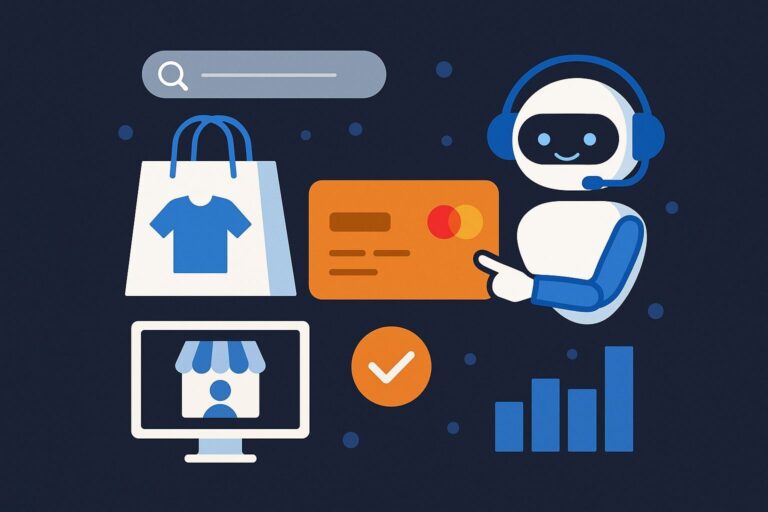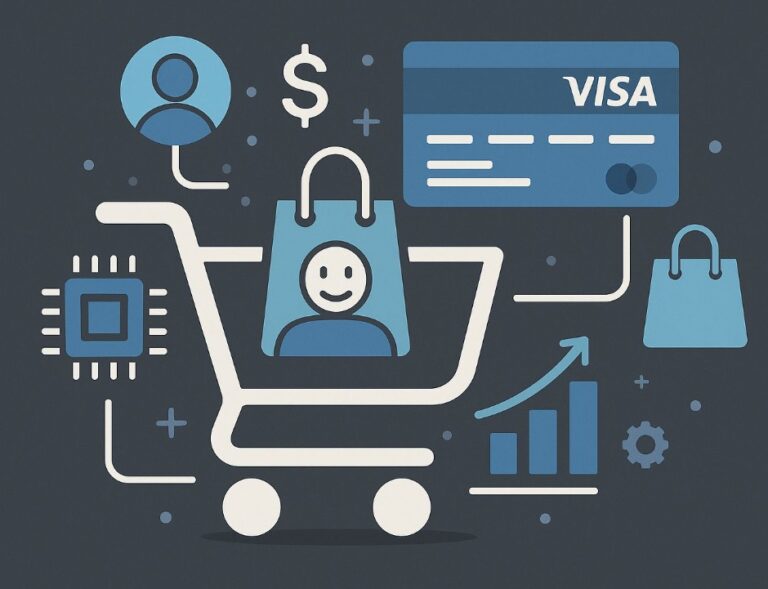According to Capgemini, over 58% of consumers now turn to generative artificial intelligence for product and service recommendations, compared to only 25% in 2023. This major uptick signals more than a change in how people search. It’s setting the precedent for agentic shopping, a frictionless online shopping experience handled by intelligent agents.
These intelligent agents don’t just suggest what to buy. Unlike conversational AI models that simply respond to prompts or handle customer service, these agents learn your preferences, respect your budget, and make decisions for you. Agentic shopping removes the hassle of decision-making and turns browsing into a hands-off, personalized shopping experience shaped entirely around your needs.
What Is Agentic Shopping
Agentic shopping is the process of using autonomous AI agents to handle product discovery, evaluation, and purchase on behalf of the user. Instead of clicking through sites, comparing options, and managing checkouts manually, shoppers define their goals or preferences, and an intelligent agent does the rest.
These agents interpret intent, filter choices based on user-defined parameters (like price, brand, or features), and complete the transaction, often without the user visiting a single product page.
In other words, you tell the agent what you need, like, “Find me size 10 running shoes with a foam sole under $100”, and the agent handles everything else. It finds the retail store, checks if the product is available, applies promo codes, pays for it, and even schedules the delivery.
How Does Agentic Shopping Work?
For agentic commerce shopping agents to take over the task of online shopping, they need to be powered by large language models (LLMs) in order to understand language, reason through options, and make decisions based on logic, goals, and real-world data.
While the technology behind these intelligent agents is complex, the process of agentic shopping is fairly straightforward, and it goes like this:
- A clear prompt, such as “Buy me black, XL thermal underwear from Ridge, under $150, and have it delivered by Friday.”
- In most cases, one agent can’t do everything alone. That’s why many agentic systems use multi-agent setups. For example:
- Search agent scans online catalogs for matching products and product information
- Review agent checks ratings and user feedback
- Price agent compares deals across different sites
- Negotiation agent looks for coupons or request a better price via APIs
For these agents to seamlessly work together, we need multi-agent orchestration systems, such as LangChain, which manage who does what and in what order.
- For the product discovery and evaluation to be precise, agents must connect to ecommerce platforms through APIs—rules and protocols that allow applications to communicate with each other. By doing so, your agent gains access to:
- Product catalogs
- Real-time prices and product availability
- Delivery options and timelines
- Payment gateways to securely complete purchases
- When ready, agents complete purchases using tokenized payments (via Visa or Mastercard) within your set limits.
How Does an AI Agent Know Exactly What I Want?
You need to train your agent to take advantage of its agentic AI capabilities. That means giving it clear input, including all the necessary details. Essentially, feed it anything that helps it shop like you would.
If you’re shopping for clothes, consider size, favorite brands, color, materials, budget, etc. If you’re grocery shopping, consider likes and dislikes, preferred delivery dates or times, dietary restrictions or allergies, brand preferences, etc.
The more specific you are, the better the results. Over time, your will agent will learn preferences, like sizing, brands, colors, etc., and anticipate your needs. Eventually, your prompt could be as simple as “Buy me thermal underwear”, and the agent will assume the rest based on the gathered data.
Is Agentic Shopping Safe?
Yes—agentic shopping is as safe, if not safer, than traditional online shopping. This is made possible through four main pillars:
- Tokenized payments
- User-controlled authorization
- Agent’s digital identity
- Trail auditing
Tokenized Payments
According to Visa, tokenized transactions (which agentic shopping transactions rest on) reduce fraud by over 26% compared to conventional online shopping methods.
In other words, AI shopping agents never store or transmit your raw credit or debit card data. Instead, they use tokenized credentials, which expire quickly and are commonly limited to a single transaction. This minimizes fraud risk and prevents misuse if intercepted, as tokenized credentials can’t be reverse-engineered to steal your sensitive data.
Behind such seamless transactions is a network of payment providers, authentication systems, and fraud prevention layers working to make agent-initiated purchases safe, fast, and reliable, such as:
| Visa Intelligent Commerce | Visa’s Intelligent Commerce platform powers agentic shopping by issuing AI-ready tokens, enforcing authentication, and allowing agents to act within purchase limits securely. It integrates with banks and merchants globally and shares structured metadata for dispute resolution. |
| Mastercard Agent Pay | Mastercard’s Agent Pay uses agentic tokens to securely authorize AI agents across conversational platforms. Built on trusted tokenization, it includes features like merchant category controls, spending limits, and biometric verification to ensure user safety. |
| PayPal Agent Toolkit & MCP Server | PayPal launched an Agent Toolkit and MCP server for developers to integrate payments, orders, invoices, and shipment tracking into agent workflows using LangChain, OpenAI SDKs, or Vercel AI. This stack is also powering Perplexity Pro’s in-chat checkout. |
| Stripe Agent Toolkit & Virtual Cards | Stripe’s Agent Toolkit integrates with frameworks like LangChain and CrewAI, allowing agents to issue single-use virtual cards and manage payments, products, and billing—all through function-calling APIs. It offers secure, usage-based billing embedded in agent workflows. |
User-controlled Authorization
You may retain a degree of control to prevent agentic systems from overspending, fraud, or unintended purchases, ensuring they operate strictly within your defined parameters. To do this, you could:
- Request pre-approval for all transactions.
- Set up session-limited permissions, where agents can only act within a short timeframe.
- Establish spending limits, whether daily, weekly, or monthly, based on what you want to automate (shopping for groceries, supplements, clothes, etc.).
- Specify brand or category restrictions
Agent’s Digital Identity
Each agent is issued a unique digital identity with clearly defined permissions, governed by identity and access management (IAM) frameworks. Think of these identities like job roles—your shopping AI assistant only gets the clearance it needs to do its job.
These identities are context-aware, meaning they’re only valid for a specific session or transaction type. It means your agent can’t overspend, access unrelated accounts, or leak your data—even if compromised. In other words, an agent can only act within its assigned task, and anything outside that scope is denied by design.
Trail Auditing
Everything your agent does, from browsing to buying, is logged. This provides transparency, allows for rollback in case of errors, and supports dispute resolution. In case an unauthorized or incorrect purchase occurs, the audit trail enables you to trace exactly what decision the agent made and why.
This level of visibility is especially important when multiple agents interact, ensuring that every step of the process remains accountable and reconstructable.
What Are the Benefits of Agentic Shopping?
Now that we understand that agentic shopping is safe, let’s take a look at how this new era of digital commerce can benefit the customer experience:
Agentic Shopping Saves Time
One of the clearest benefits of agentic shopping is how much time it can save. Instead of opening dozens of tabs, checking reviews, comparing prices, and manually completing purchases, an AI agent can handle everything on your behalf. Think of it as intelligent delegation. The agent knows your preferences, budget, brand loyalties, and can act accordingly, drastically reducing the time you’d normally spend making shopping decisions.
Let’s say you’re getting ready to throw a party. What might have taken you hours, or possibly even days, now takes several minutes. Just inform your AI agent about the number of guests, their preferences in terms of food and beverages, explain the theme (if there is one), and let it do its magic.
Experience More Personalized Shopping Experiences with Agentic Shopping
Instead of generic “you might also like” suggestions, AI agents tailor recommendations based on your actual behavior, preferences, past purchases, and real-time context. The result? Fewer irrelevant products, more options that match what you actually want. Think of it as reverse-engineered customer data brands use to send you promotional offers and recommendations, only this time, you are actually looking to buy something.
For example, if you typically buy alcohol-free skincare under $40 and avoid floral scents, your agent remembers that. When you ask it to find a new moisturizer, it skips over options that don’t fit your filters—even if they’re bestsellers—and shows you the ones that do. Over time, the recommendations get sharper as your agent learns your unique preferences.
AI Agents Help You Spend Less
Since AI agents automatically compare prices, apply coupons, and track rebates, they can often save users more than they’d on their own. In fact, 74% of Americans believe AI finds better deals for them, and a survey showed consumers saved on average $83 annually, with 1 in 10 saving over $200 thanks to AI shopping tools.
Let’s say you’re shopping for a new laptop. Your agent scans relevant retailers like Amazon or Walmart, filters items to your specs, applies available promo codes, and finds the best deal. Or, if it can’t find anything at the moment, it could alert you when the price drops.
Agentic Shopping Reduces Decision Fatigue
While many of us enjoy browsing online stores and searching for the right product or the best deal, that isn’t the case for everyone. Some people hate it. Too many choices make shopping stressful and unsuccessful.
In fact, Accenture found that 72% of consumers find online shopping overwhelming, and 74% of them abandoned their carts.
Agentic shopping circumvents this issue by having AI agents do the heavy lifting. Instead of scrolling through dozens of options, agents curate a focused shortlist, making shopping more efficient and less tiring, regardless of what you’re searching for.
Replenishments Are Made Easy with Agentic Shopping
By learning from your purchase history, preferences, and usage habits, AI agents can anticipate when you’re about to run low on essentials—like skincare products, pantry staples, pet food, or vitamins—and reorder them automatically by tracking consumption cycles and factoring in delivery times to ensure your supplies arrive just as you need them, not after you’ve run out.
AI agents can also handle substitutions (if a preferred product is out of stock). They can even adjust frequencies based on feedback and modify future orders accordingly. This level of automation frees you from repetitive errands and ensures your essentials are always on hand.
Improved Accessibility with Agentic Shopping
Saving time and money isn’t the only use case for autonomous agents. One of the best agentic AI applications is that it makes online buying easier for people with mobility issues, vision problems, or other accessibility needs. With AI-powered voice assistants and smart support tools, users can shop without needing to scroll, type, or use a mouse.
A NetChoice study shows that virtual assistants and voice commands improve shopping for people with disabilities. Voice-powered shopping helps those with limited vision or motor control, and AI plugins make websites easier to use with screen readers.
For example, a blind user could say, “Find a battery-powered coffee grinder under $75,” and their agent would handle the rest—searching, comparing, and buying, all without the user needing to see the screen.
Are There Drawbacks to Agentic Shopping?
While it is obvious that agentic commerce will improve online shopping, making it super convenient for people to perform mundane shopping tasks, save time and money, and eliminate decision fatigue, there are also some concerns to be wary of.
| Drawback | Explanation |
| AI Hallucinations | AI systems are known to generate inaccurate or irrelevant results, misinterpret user intent, meaning AI agents may make poor purchase decisions based on flawed reasoning. |
| Overpersonalization | AI-driven personalization may limit variety by continuously recommending similar products, potentially reinforcing existing preferences or missing better alternatives. |
| Loss of Control | Users may feel disconnected from the decision-making process, especially if agents act autonomously with minimal oversight. |
| Privacy Concerns | Agents require access to personal data—purchase history, preferences, and financial information—which increases exposure to data misuse or leaks. |
| Spending Risks | Without tight guardrails, agents could overspend, miss better deals, or make purchases that the user wouldn’t have approved. |
| Transparency Issues | It’s not always clear why an agent chose a specific product. Users might not know if the agent’s decision was driven by preferences, price, sponsorship, or bias. |
| Limited Compatibility | Not all stores or brands may support agentic integrations, limiting access to products or deals unless users shop manually. |
| Security Threats | Like any digital system, agents can be targeted by hackers, potentially compromising payment information or personal data. |
Which Intelligent Shopping Agents Can You Test Today?
While it will take some time for agentic AI to become what it needs to become, several companies have already launched their intelligent AI agents, which you can test today:
1. Alexa+ (Amazon)
If you’re curious about trying agentic shopping today and you’re an Amazon Prime subscriber, Alexa+ is a good place to start.
Built on Amazon’s latest generative AI and agentic automation architecture, Alexa+ goes far beyond simple voice commands. You can now ask, “Can you reorder the coffee I liked last month?” and Alexa+ will understand, find the right product, check delivery timelines, and place the order on your behalf.
It’s powered by Amazon’s in-house LLM, Nova, and partners like Anthropic’s Claude, giving it the ability to interpret nuanced requests and complete tasks across Amazon Fresh, Whole Foods, or Grubhub.
2. Operator (Open AI)
Operator from OpenAI is another option available right now. As part of the ChatGPT Pro plan (which is considerably pricer than Alexa+, thanks to its other abilities), Operator can autonomously navigate through web pages. It can also search multiple sites at the same time, fill out forms, and prepare your cart.
Operator is powered by the Computer-Using Agent (CUA) model, which combines GPT‑4o’s vision capabilities with reasoning to interact with on-screen elements. In other words, it can click buttons, type, and scroll like a human would.
While it’s not perfect at the moment, it can be pretty great for tasks like grocery shopping or even booking a holiday.
Buy with Pro (Perplexity)
Perplexity’s Buy with Pro feature lets Pro subscribers in the U.S. research, compare, and purchase products all within Perplexity’s interface.
The new agentic feature understands customer needs and offers one-click checkout and lets you save billing and shipping information through a secure portal. If available, Buy with Pro even includes free shipping on eligible orders.
Powered by integrations with platforms like Shopify, Perplexities Pro agent generates product cards featuring key specs, reviews, and pros and cons—so you don’t have to leave the app to shop or review any items.
Buy for Me (Amazon)
Amazon’s Buy for Me lets you purchase items that are not listed on Amazon without leaving the Amazon mobile app. To use it, simply tap the Buy for Me button within the app, confirm the details, and Amazon’s AI agent—powered by Nova and Anthropic’s Claude—fills in your info, completes the transaction, and updates your Amazon order tracker.




